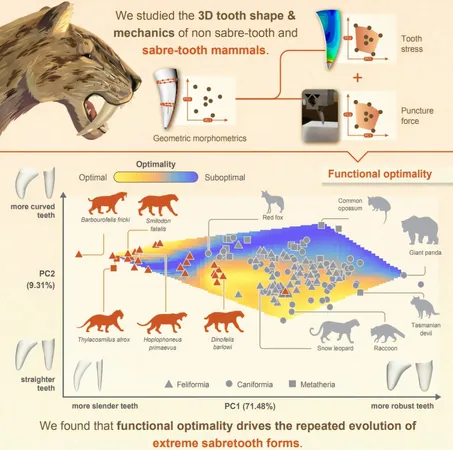
Exploring the Deadly Design: Why Saber-Toothed Predators Were Master Hunters
2025-01-09
Author: Arjun
Recent research has shed light on the fascinating world of saber-toothed predators, most famously represented by the Smilodon. A groundbreaking study titled "Functional optimality underpins the repeated evolution of the extreme 'saber-tooth' morphology," published in Current Biology, has revealed the remarkable effectiveness of these notorious teeth as tools for hunting.
The study, spearheaded by scientists from the University of Bristol in partnership with Monash University, illustrates that the elongated, razor-sharp canine teeth of saber-toothed predators provided a significant advantage. These blade-like teeth were perfectly adapted for puncturing the flesh of prey, making them lethal weapons in the pursuit of survival.
This research not only explains the multiple independent evolutions of 'saber-tooth' morphology—evident in at least five different mammalian lineages—but also hints at the reasons behind their eventual extinction. As these predators became more specialized hunters, they may have become increasingly susceptible to ecological shifts and the decline of their prey populations, creating what researchers refer to as an "evolutionary ratchet."
To understand the mechanics behind the saber-toothed design, the research team conducted a series of biting experiments using 3D-printed replicas made of steel. Their work examined the shape and functional performance of teeth from 95 carnivorous mammal species, including 25 saber-toothed varieties. This meticulous analysis allowed them to discover an optimal balance in tooth design: sharp enough to penetrate prey while also robust enough to withstand the forces of biting without shattering.
Lead researcher, Dr. Tahlia Pollock, a member of Bristol's Paleobiology Research Group, stated, "Our findings enhance our understanding of how extreme adaptations arise—insights that extend beyond saber-toothed predators to various facets of nature."
The study also challenges the long-standing belief that saber-toothed predators could only be categorized as "dirk-toothed" or "scimitar-toothed." Instead, the research reveals a surprising variety of tooth shapes among these ancient beasts, ranging from the elegantly curved teeth of Barbourofelis fricki to the more robust and straighter teeth of Dinofelis barlowi. Such diversity hints at a broader array of hunting strategies employed by these predators than previously recognized.
Looking forward, the research team is eager to expand their analysis to include various tooth types across species to uncover the biomechanical trade-offs that have influenced the evolution of distinct dental structures throughout the animal kingdom.
Earnest insights from this study have the potential to impact not only evolutionary biology and biomechanics but also fields such as engineering, where the principles of bioinspiration are increasingly being applied. So, what does this mean for the future of science and technology? The exploration of nature's designs is only just beginning, and who knows what remarkable adaptations are yet to be discovered!
 Brasil (PT)
Brasil (PT)
 Canada (EN)
Canada (EN)
 Chile (ES)
Chile (ES)
 Česko (CS)
Česko (CS)
 대한민국 (KO)
대한민국 (KO)
 España (ES)
España (ES)
 France (FR)
France (FR)
 Hong Kong (EN)
Hong Kong (EN)
 Italia (IT)
Italia (IT)
 日本 (JA)
日本 (JA)
 Magyarország (HU)
Magyarország (HU)
 Norge (NO)
Norge (NO)
 Polska (PL)
Polska (PL)
 Schweiz (DE)
Schweiz (DE)
 Singapore (EN)
Singapore (EN)
 Sverige (SV)
Sverige (SV)
 Suomi (FI)
Suomi (FI)
 Türkiye (TR)
Türkiye (TR)
 الإمارات العربية المتحدة (AR)
الإمارات العربية المتحدة (AR)